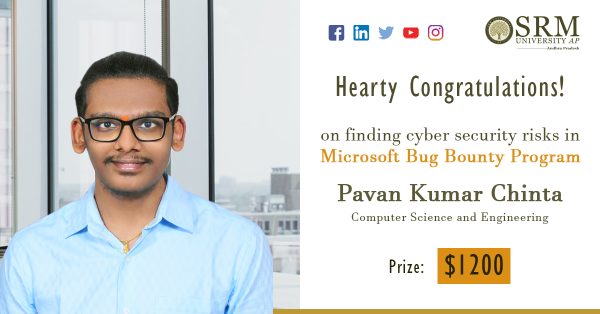Cyber security enthusiast wins $1200 in Microsoft Bug Bounty Program
 Taking your knowledge and solving real-world problems is the true intention of education. SRM University-AP is delighted to see Pavan Kumar Chinta achieve this aspiration and obtain $1200 Bounty from Microsoft Bug Bounty Program on November 13, 2021. The
Taking your knowledge and solving real-world problems is the true intention of education. SRM University-AP is delighted to see Pavan Kumar Chinta achieve this aspiration and obtain $1200 Bounty from Microsoft Bug Bounty Program on November 13, 2021. The
Bounty of $1200 was presented to Pavan by Mr Jason Pessemier, Microsoft Security Program Manager.
Pavan Kumar Chinta has keen enthusiasm with Cyber Security as specialization in the Department of Computer Science and Engineering. Microsoft is not the only company that Pavan has managed to impress.
He has also reported Server-Side Request Forgery (SSRF) a high severity bug , in Mercedes Benz portal, and Groww by finding Broken Authentication and Security Misconfiguration. He was acknowledged by both the organisations and received swags from Groww.
Pavan has spared no space in his investigation of bugs. He was acknowledged by NCIIPC (A unit of NTRO), the Government of India, for discovering Sensitive Information Disclosure like PNR, Name, Mobile Number, etc., of the passengers in IRCTC’s authorised partner. He has also reported bug issues to GeeksforGeeks and Google.
Pavan expressed “Prof. T Ragunathan, (Associate Dean (Engineering) – School of Engineering and Sciences), guided me and encouraged to study the University’s Cyber Security structures as well. With constant guidance from Dr Priyanka, Assistant Professor, Computer Science Engineering, I was able to work with pentesting tools and develop reconnaissance methodologies. This lockdown helped me to discover and build myself. His short-term goal is to secure MAMAA (Meta, Apple, Microsoft, Amazon, and Google’s parent company, Alphabet).
This is an excellent start for a 3rd-year student. We hope to see the series of security risk investigations that began here to stay with him, and that he goes on to make tremendous achievements and makes the internet a safer space.
- Published in CSE NEWS, Departmental News, News, Students Achievements
CSE student wins Best Paper award and cash prize in International conference
 Padmaja Buggaveeti, an outstanding student from 3rd-year Computer Science Engineering at SRM University-AP, has won Best Paper (Third Prize) and a cash prize of Rs 10000 /- (Ten thousand rupees only) at the 4th ISEA Virtual International Conference on Security and Privacy 2021. Ms Padmaja, under the mentorship of her guide Dr V M Manikandan, presented a paper titled “A Novel Prediction Error Histogram Shifting-based Reversible Data Hiding Scheme for Medical Image Transmission” at the International Conference on Security and Privacy, sponsored by Information Security and Education Awareness Project Phase-II (ISEA-II) and organised by IIT (ISM) Dhanbad, India from October 27-30, 2021.
Padmaja Buggaveeti, an outstanding student from 3rd-year Computer Science Engineering at SRM University-AP, has won Best Paper (Third Prize) and a cash prize of Rs 10000 /- (Ten thousand rupees only) at the 4th ISEA Virtual International Conference on Security and Privacy 2021. Ms Padmaja, under the mentorship of her guide Dr V M Manikandan, presented a paper titled “A Novel Prediction Error Histogram Shifting-based Reversible Data Hiding Scheme for Medical Image Transmission” at the International Conference on Security and Privacy, sponsored by Information Security and Education Awareness Project Phase-II (ISEA-II) and organised by IIT (ISM) Dhanbad, India from October 27-30, 2021.
Abstract: In this paper, Ms Padmaja proposed a new prediction error histogram shifting-based reversible data hiding scheme that ensures a high embedding rate and lossless image recovery. The pixels in the images are categorised into two different classes: white pixels and black pixels based on a checkerboard pattern. To predict the black pixel value for finding the prediction, they used the average of three pixels out of 4-neighbourhood pixels, which are very close to the central pixel value. The prediction error histogram is considered for further data hiding through the histogram shifting approach. An efficient overflow handling technique is used for this. The proposed algorithms were implemented using Matlab-2020, and the experimental study of the proposed scheme is carried out on the standard medical images and natural images.
International Conference on Security and Privacy is a premier conference focused on information security and privacy. This year’s conference was sponsored by Information security and Education Awareness Project Phase-II (ISEA-II) and organised by IIT (ISM) Dhanbad, India, from October 27-30, 2021.
Prize Details: Best Paper (Third Prize) and a cash prize of Rs. 10000 /- (Ten thousand rupees only).
Let’s hear what Ms Padmaja says about her achievement!
I thank Dr V M Manikandan, Assistant Professor in the Department of Computer Science and Engineering, for his valuable guidance in this research work. Winning the best paper award and cash prize in a reputed conference, ISEA-ISAP, has strikingly boosted my confidence to do research. I am grateful to all the faculty members of the CSE Department for their kind support and encouragement throughout my study at SRM University-AP.
- Published in CSE NEWS, Departmental News, News, Research News
BSc Biology student to intern at Harvard Medical School
 Rallapalli Bhavana Durga, a budding researcher from BSc Biology at SRM University-AP, earns an international internship at Harvard Medical School. The six-month internship will focus on bioengineering, cancer, and other biomedical research. The days at Harvard Medical School will impart an understanding of the development of cancer in an in-vitro model fabricated by the bioengineering approach.
Rallapalli Bhavana Durga, a budding researcher from BSc Biology at SRM University-AP, earns an international internship at Harvard Medical School. The six-month internship will focus on bioengineering, cancer, and other biomedical research. The days at Harvard Medical School will impart an understanding of the development of cancer in an in-vitro model fabricated by the bioengineering approach.
The Office of International Relations and Higher Studies guided Ms Bhavana throughout the application process. Every eligible student who applies for study abroad programmes is given orientation and motivation to bridge the attainment gap. They share information about various research/internships/projects with interested students. Ms Bhavana qualified the eligibility criteria for Harvard Medical School, which focuses on Tissue engineering and other Biomedical engineering fields. After completing the screening, she received a welcome e-mail for the internship at Dr Shiladitya Sengupta & Haelin Jang’s lab in Brigham and Women’s Hospital, Harvard Medical School. During the internship period, she will be involved in i) research-related activities involving the hands-on discovery of new biological pathways in cancer metastasis and (ii) writing for publications.
“I have received a lot of support from my professors and Dr Swetha Pasupuleti, Associate Director, International Relations”, says Ms Bhavana. “From the beginning, all my professors have been very encouraging, and their suggestions and criticisms were constructive. Dr Swetha has been very supportive and reassuring during the application process, taking away my inhibitions. I feel excited about my internship”, she added.
To tackle barriers to postgraduate education, SRM University-AP has designed ambitious programmes that improve the admission of students to global institutions. International Relations and Higher Studies department ensure that all students and faculty on campus are supported and assisted in gaining access to resources in order to achieve the vision and mission of SRM University-AP in becoming a multidisciplinary global university.
- Published in Biology News, Departmental News, IR-News, News, Students Achievements


 SRM University-AP is pleased to announce that
SRM University-AP is pleased to announce that